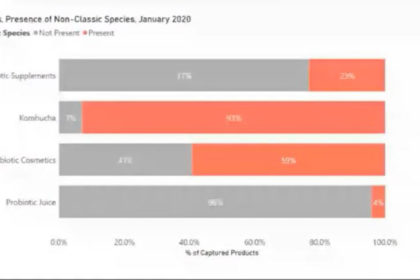
Kombucha and cosmetics are driving growth in the probiotic and prebiotic markets by making products that use non-classic strains of bacteria.
The e-commerce market for probiotic supplements was estimated at $973 million across 20 countries in 2020. America accounts for almost half of those sales. Ewa Hudson, director of insights for Lumina Intelligence, shared this info at the Probiota Americas 2020 Conference. (Lumina and Probiota Americas are parts of William Reed Business Media, the parent company for FoodNavigator.com.) The session, New Horizons for Prebiotics & Probiotics, included Lumina’s insight into non-classic bacteria strains and a panel discussion with leaders in the probiotics field.
In 2020, 32% of all probiotics in America — and 41% of the best-selling ones — contained non-classic species. Hudson said this species classification is a messy space, especially from a consumer’s perspective, because there are so many species. Kombucha includes the most non-classic probiotic species — of those products with probiotics, 93% include non-classic bacteria .
Most products with probiotics include one of the four common bacteria species: lactobacilli, bifidobacterium, bacillus and saccharomyces. Lumina excluded these four from their research to focus on the growth of the non-classic probiotic strains. These include: streptococcus thermophilus, kombucha culture, lactococcus lactis, bifida ferment lysate, enterococcus faecium, streptococcus salivarius, clostridium butyricum and streptococcus faecalis.
Though probiotics are often used in supplements, more fermented food and beverage manufacturers are using probiotic strains in their products, especially in the growing alternative protein market.
Synbiotics are also becoming more widely used; the study found synbiotics were the most prevalent formulate in probiotics. Synbiotics are a combination of both prebiotics and postbiotics. A synbiotic ensures that probiotics will have a food source in the gut.
(Probiotics are live microorganisms, friendly bacteria that provide health benefits. Probiotics can be found in fermented food and taken as supplements. Prebiotics are dietary fibers that feed the probiotics. Postbiotics are an emerging concept in the “biotics” space — postbiotics are the waste byproduct of probiotics.)
“With probiotics, we are really only starting to scratch the surface with the development of synbiotics,” says Jens Walter, PhD, professor of ecology, food and the microbiome at APC Microbiome Ireland.
The new generation of probiotics will depend on strains that are “efficacious in the gut,” Walter noted.
“If you look into the probiotic market, most of the lactobacillus species — and also species like bifidobacterium lactis — are not inherent organisms of the human gut. We’re using a lot of organisms that I would argue have an ecological disadvantage in the gut,” Walter says. “If you’re talking about next generation probiotics, I think what will become is we are looking for the key players in the gut, specifically key players that are underrepresented or linked to certain benefits, and then we are trying to put them back in the ecosystem.”
It’s challenging to find a prebiotic or postbiotic that is precise, he continues.
“Every human has a distinct microbiome. So it’s likely a synbiotic designed for one human may not be as functional in another human,” Walter says. “The opportunities here are tremendous.”
Daniel Ramon Vidal, vice president of research and development and health and wellness at the American food processing company Archer-Daniels-Midland (ADM), also spoke. He noted that the human body is made up of trillions of microbial cells, but we know little about these microbial worlds.
“There is an enormous amount of possibilities to isolate new strains that are living in our body,” Daniels says. “We need as much science as possible, that’s my message”
The panel agreed that postbiotics has become one of the next great concepts that scientists, manufacturers and gastroenterologists have latched onto. But consumers are not as familiar with postbiotics as they are with probiotics and prebiotics , notes Justin Green, PhD, director of scientific affairs for EpiCor, a postbiotic ingredient produced by Cargill.
“This causes more confusion, so I think that’s going to be another interesting aspect of postbiotics — both the identity of what postbiotics are and how it confers its benefits and (how that will be) communicated to the consumer,” Green says.
